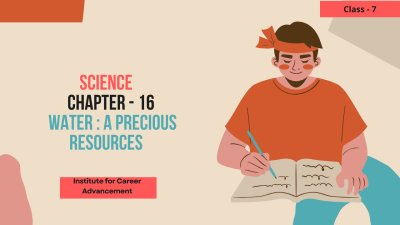Course description
Here’s an overview of what students usually learn:
Introduction to Water as a Resource:
Understanding the significance of water for living organisms, ecosystems, agriculture, industry, and daily life.
Exploring the water cycle and how water is distributed on Earth.
Sources of Water:
Studying different sources of water such as rivers, lakes, groundwater, and reservoirs.
Learning about the accessibility and distribution of freshwater compared to saltwater.
Water Management:
Importance of sustainable water management practices.
Studying the role of watersheds, aquifers, and water conservation strategies in ensuring water availability.
Water Quality and Pollution:
Understanding factors affecting water quality, including pollutants from human activities and natural sources.
Learning about the impacts of water pollution on ecosystems and human health.
Water Conservation:
Exploring methods and strategies for conserving water resources at individual, community, and global levels.
Promoting responsible water use habits and technologies to reduce water consumption.
Global and Local Water Issues:
Investigating global water challenges such as water scarcity, unequal distribution, and access to clean water.
Studying regional or local water issues and initiatives aimed at addressing them.
Climate Change and Water:
Understanding how climate change affects water availability, precipitation patterns, and freshwater resources.
Exploring adaptation strategies and resilience measures to mitigate the impacts of climate change on water.
Human Rights and Water Access:
Discussing the importance of access to clean and safe drinking water as a basic human right.
Examining issues related to water equity and social justice.
Case Studies and Examples:
Analyzing case studies from around the world that highlight successful water conservation projects, community initiatives, or challenges faced in managing water resources.
Role of Individuals and Communities:
Empowering students to take proactive roles in water conservation efforts within their homes, schools, and communities.
Encouraging advocacy for sustainable water management practices and policies.
শিক্ষার্থীরা সাধারণত কী শিখে তার একটি সংক্ষিপ্ত বিবরণ এখানে দেওয়া হল:
সম্পদ হিসেবে পানির ভূমিকা:
জীবন্ত প্রাণী, বাস্তুতন্ত্র, কৃষি, শিল্প এবং দৈনন্দিন জীবনের জন্য পানির তাৎপর্য বোঝা।
জল চক্র অন্বেষণ এবং কিভাবে জল পৃথিবীতে বিতরণ করা হয়.
পানির উৎসঃ
পানির বিভিন্ন উৎস যেমন নদী, হ্রদ, ভূগর্ভস্থ পানি এবং জলাধার অধ্যয়ন করা।
লবণাক্ত পানির তুলনায় স্বাদু পানির প্রবেশযোগ্যতা এবং বিতরণ সম্পর্কে শেখা।
পানি ব্যবস্থাপনা:
টেকসই পানি ব্যবস্থাপনা অনুশীলনের গুরুত্ব।
জলের প্রাপ্যতা নিশ্চিত করার জন্য জলাশয়, জলাভূমি এবং জল সংরক্ষণের কৌশলগুলির ভূমিকা অধ্যয়ন করা।
পানির গুণমান এবং দূষণ:
মানুষের ক্রিয়াকলাপ এবং প্রাকৃতিক উত্স থেকে দূষক সহ জলের গুণমানকে প্রভাবিত করে এমন কারণগুলি বোঝা।
বাস্তুতন্ত্র এবং মানব স্বাস্থ্যের উপর জল দূষণের প্রভাব সম্পর্কে শেখা।
জল সংরক্ষণ:
ব্যক্তি, সম্প্রদায় এবং বিশ্বব্যাপী জল সম্পদ সংরক্ষণের পদ্ধতি এবং কৌশলগুলি অন্বেষণ করা।
জল খরচ কমাতে দায়িত্বশীল জল ব্যবহারের অভ্যাস এবং প্রযুক্তি প্রচার করা।
বৈশ্বিক এবং স্থানীয় জল সমস্যা:
জলের ঘাটতি, অসম বন্টন এবং বিশুদ্ধ জলের অ্যাক্সেসের মতো বিশ্বব্যাপী জলের চ্যালেঞ্জগুলি তদন্ত করা।
আঞ্চলিক বা স্থানীয় জল সমস্যাগুলি অধ্যয়ন করা এবং সেগুলি সমাধানের লক্ষ্যে উদ্যোগ নেওয়া।
জলবায়ু পরিবর্তন এবং জল:
জলবায়ু পরিবর্তন কীভাবে পানির প্রাপ্যতা, বৃষ্টিপাতের ধরণ এবং স্বাদু পানির সম্পদকে প্রভাবিত করে তা বোঝা।
জলের উপর জলবায়ু পরিবর্তনের প্রভাবগুলি প্রশমিত করার জন্য অভিযোজন কৌশল এবং স্থিতিস্থাপকতার ব্যবস্থাগুলি অন্বেষণ করা।
মানবাধিকার এবং জল অ্যাক্সেস:
মৌলিক মানবাধিকার হিসাবে বিশুদ্ধ ও নিরাপদ পানীয় জলের অ্যাক্সেসের গুরুত্ব নিয়ে আলোচনা করা।
জলের সমতা এবং সামাজিক ন্যায়বিচার সম্পর্কিত সমস্যাগুলি পরীক্ষা করা।
কেস স্টাডিজ এবং উদাহরণ:
বিশ্বজুড়ে কেস স্টাডি বিশ্লেষণ করা যা সফল জল সংরক্ষণ প্রকল্প, সম্প্রদায়ের উদ্যোগ, বা জল সম্পদ পরিচালনায় সম্মুখীন হওয়া চ্যালেঞ্জগুলি তুলে ধরে।
ব্যক্তি এবং সম্প্রদায়ের ভূমিকা:
শিক্ষার্থীদের তাদের বাড়ি, স্কুল এবং সম্প্রদায়ের মধ্যে জল সংরক্ষণের প্রচেষ্টায় সক্রিয় ভূমিকা নিতে সক্ষম করা।
টেকসই জল ব্যবস্থাপনা অনুশীলন এবং নীতির জন্য উকিল উত্সাহিত করা।



















